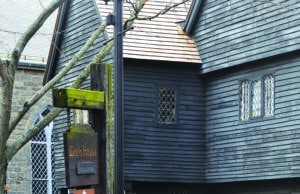
Salem is being haunted by state zoning laws that have given a gang of four members on a city council of 11 the ability to halt housing-friendly zoning changes.
When Marc Draisen, one of the more mild-mannered public servants out there, has taken to calling their actions “shameful,” you know the NIMBY minority on the Salem City Council has stooped to a new low.
It’s a quartet that, when faced with just about any proposal that would boost the construction of badly needed new homes in the North Shore city, has just one answer, and that’s “No! No! No!”
And the stubborn foursome has left Salem Mayor Kim Driscoll spinning her wheels for the past three years since she was reelected for a fourth term on a pledge to tackle a housing crisis that has seen prices and rents soar in the seaside city.
It comes against the backdrop of an until–recently booming high-tech and biotech-driven regional economy, one that has led to an influx of younger renters and buyers in Salem as housing costs in the Boston area’s urban core spiral upwards.
“It’s truly shameful,” Draisen, a former state representative and current head of the Metropolitan Area Planning Council, told The Salem News, “that a tiny number of people are able to prevent the city of Salem from adopting the progressive and meaningful policies that address the housing crisis.”
That’s strong talk from anyone, but especially so from Draisen, whose agency is not known not for firebrand rhetoric, but rather for its data–packed studies on housing demand, transportation and other key infrastructure issues in Greater Boston.
Years of Dithering Hurt City
“Shameful” – as well as “blockheaded,” “blinkered” and “willfully misinformed” – are all apt descriptions for this renegade faction.
Driscoll has spent years pushing plans to to turn old municipal and religious buildings into housing, to require developers who build new housing to include a percentage of subsidized, below-market units and to allow homeowners to add on in-law apartments – also called accessory dwelling units – and all have come to naught.
The in-law apartment proposal is a prime example, having been batted about inconclusively by the council for more than a year.
Objections by opponents on the council include fear that the granny flats will lead to rampant overdevelopment and overcrowding, despite not a shred of evidence that this has actually happened in other towns or cities.

Gov. Charlie Baker exits a press briefing at the State House on June 24. Baker is making Salem the poster child for his push to begin reforming Massachusetts’ zoning. Photo by Sam Doran | State House News Service
City councilors in the Witch City have also endlessly hemmed and hawed over a proposal that would require housing developers to include certain percentage of affordable units in each project, hung up over whether it should be 10 percent or higher, among other sticking points.
Despite projections by Draisen’s MAPC that Salem is nowhere close to building enough housing to keep up with current demand, members of the No! No! No! block want to slow down the pace of development, drawing upon who–knows–what insights to insist the hundreds of units now under construction might be enough.
According to MAPC’s study, Salem will need anywhere from 1,900 to 2,725 new units by 2030 just to keep up with demand, let alone to put a dent in prices.
Another councilor has cited the amount of luxury housing getting built – and the corresponding dearth of housing for seniors and veterans – to rationalize his opposition to just about any effective measures to build anything, anywhere, anytime.
Meanwhile, housing prices in Salem have shot up more than 21 percent in the past five years alone, hitting a median sale price of $415,000 in May, according to The Warren Group, publisher of Banker & Tradesman.
A Silver Lining?
That just four of the 11 members of Salem’s City Council has the power to hold up housing development in the city is unfortunate, and points to a major problem that extends well past Salem.
Under state law, zoning proposals that would pave the way for new housing need to secure a two-thirds vote by a city or town’s elected officials, whether it’s the city council or the local select board.
That means in Salem, the mayor has to secure at least an 8-3 vote to pass any of other housing plans, which all hinge on zoning changes, with Driscoll’s proposals getting endlessly deferred for further study or shot down by votes of 7-4 or 6-5, which, in any normal situation, would mean a solid win.
Still, this intransigence by this handful of Salem city councilors, as maddening as it has become to the city’s affordable housing supporters, may have a modest silver lining in the overall battle to make Massachusetts an easier state in which to build new homes, condominiums and apartments.
The actions of the Salem Four have drawn the attention of Gov. Charlie Baker, who clearly hopes to make the city and the NIMBY opponents holding up progress on housing a poster child for his long-stalled Housing Choice bill, which would eliminate that vexing two-thirds rule and replace with a simple majority vote for housing-related zoning.

Scott Van Voorhis
Now maybe it’s unfair to affix the NIMBY able to the handful of housing progress holdouts on the Salem City Council.
But the alternative isn’t particularly flattering, implying the council, or at least a sizeable block on it, is populated with a bunch of nincompoops, endlessly bickering and posturing over minor details and unable to take effective action amid a housing crisis.
Either way, it’s time for the No! No! No! faction to do everyone a favor – especially all those frustrated and buyers and renters out there facing ever-higher housing costs and ever-fewer options – and either change their stripes or call it a day.
Scott Van Voorhis is Banker & Tradesman’s columnist; opinions expressed are his own. He may be reached at sbvanvoorhis@hotmail.com.





